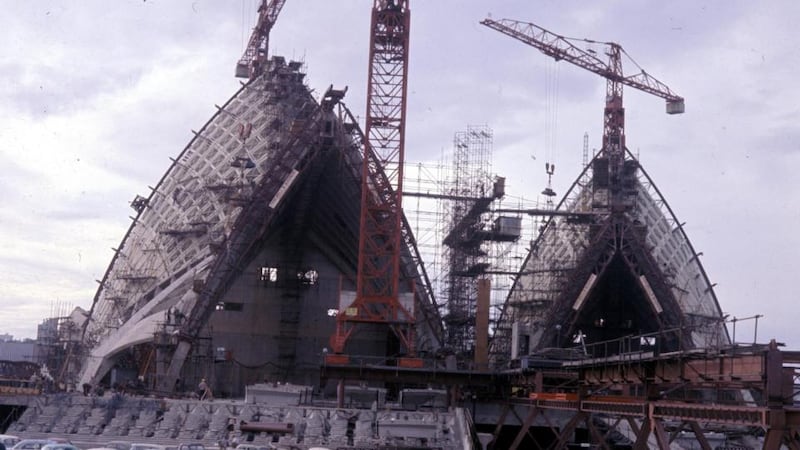In January 1977, a few days after the Pompidou Centre, in Paris, opened to the public, Peter Rice, an Irish engineer working on the construction, noticed a seemingly insignificant gesture while he was standing on the fourth floor of the building. An elderly woman sitting next to one of its gerberettes – huge joints connecting the posts and beams of its external steel skeleton – was stroking it as if it were a dog. It struck Rice that her comfort in her surroundings was crucial and that her tactile interaction with the material offered her a way into the building. "Rice had a sense of making the unfamiliar familiar," says Mick O'Kelly, who teaches sculpture at the National College of Art and Design, in Dublin. "These gerberettes remind me of enormous door handles."
Rice, who died in 1992 at the age of 57, is not a household name in Ireland, yet he was the lead engineer on some of the world's most innovative buildings, including Sydney Opera House, the Lloyd's of London building and the Pavilion of the Future, in Seville. One reason for this is precisely that Rice was an engineer: in construction, the architect's name goes on the building; the engineer's work remains unspoken. Rice's life's work challenged this hierarchy.
In 1992 he started to write An Engineer Imagines, a seminal text of late 20th-century design. That year he was diagnosed with the inoperable brain tumour that caused his death. (The book was published posthumously.) A retrospective of Rice's work, at the Farmleigh Gallery, in Dublin, contains models, details and drawings of his work on the Pompidou Centre and the Menil Gallery, in Houston, among others.

Rice was brought up in Dundalk, in Co Louth, and studied engineering at Queen's University Belfast, followed by a year at Imperial College London. He then joined Ove Arup, the international engineering consultancy, which in the late 1950s secured the contract to design and oversee the construction of Sydney Opera House.
Working in Australia as a young site engineer under the auspices of the building's architect, Jørn Utzon, Rice learned the importance of a building's articulation: its visual expressions, from its overall form right down through the structure to the connection joints – the parts of a building that require direct human manipulation. Rice realised that it is in these articulations that a building can become meaningful to people, giving them a form of entry into the nature of the building.
Rice went on to become one of the most sought-after engineers of the 1970s and 1980s, working on the IBM Travelling Pavilion, in London, Kansai international airport, in Japan, Bari football-stadium roof, in Italy, and the Full Moon Theatre, in rural France, among other projects. In 1988 he became only the second Irishman to be made an honorary fellow of the Royal Institute of British Architects. He worked closely with Renzo Piano, the lead architect on the Pompidou Centre, on several projects in the early 1980s, to the point that the Fiat car company invited them to develop a prototype.
Rice coupled his computational and analytical skills with singular design skills: he knew how construction materials were made, then and in the past, and brought this knowledge to his design suggestions, a lot of which were unconventional. But he also understood the conventions, and knew how to apply them imaginatively. When his creativity blended with that of a collaborative architect, the design decisions that emerged became more and more daring, and new building forms started to emerge.
In the early 1980s he joined forces with Ian Ritchie, the architect who designed the Spire of Dublin, and the industrial designer Martin Francis to form RFR, a cross-disciplinary building-design consultancy. It was in this environment that many further innovations came to fruition, most notably the cable-stay system, an inspired, lightweight structural system for supporting vertical glazing that is used in the CHQ building on the quays in Dublin, in Fingal County Hall and in the Westmeath county council offices (the latter two designed by the Dublin- and Berlin-based architects Bucholz McEvoy).
With the slowdown in the construction industry, engineers, architects and designers can consider some of Rice’s conclusions and rethink the engineer/architect disconnect in Irish and British building.
The ways an engineer and an architect understand and value materials are different. Where the engineer has a working knowledge of the essential properties of material – its strength, stiffness and brittleness – the architect’s concerns lie more with the nature of the surface of material. This doesn’t preclude creative collaboration; nor does an engineer’s contribution need to remain in the realm of the pragmatic.
Rice showed that an engineer’s understanding of material can also be expressed in the final aesthetic of a building. Many of his buildings are testaments to the way the disciplines of engineering and architecture have lowered their defences to collaborate successfully and humanely.
Traces of Peter Rice is at the Farmleigh Gallery, Phoenix Park, Dublin, until December 22nd
Adrian Duncan is an artist and a chartered engineer. He is coeditor of Paper Visual Art Journal


















